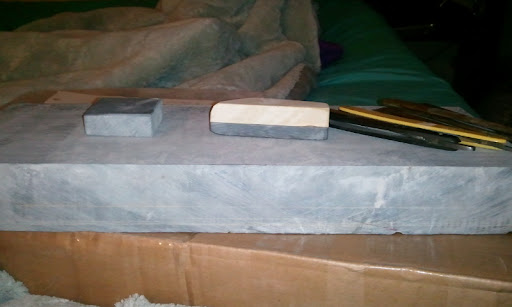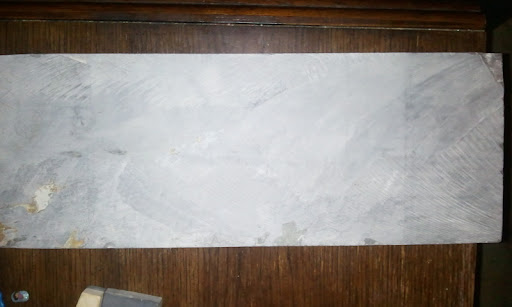Results 1 to 10 of 36
-
05-10-2011, 02:37 AM #1Senior Member

- Join Date
- Mar 2011
- Location
- Richmond, Virginia
- Posts
- 104
Thanked: 11 C15k, PHIG, C12k+, People's Hone of Unknown Grit
C15k, PHIG, C12k+, People's Hone of Unknown Grit
So, this story starts out as so many others... with this thing I bought on ebay:
15000 grit whetstone for fine honing. 2" x 6" x 16" | eBay
Pics of as delivered today here:
https://picasaweb.google.com/nphocus/HAD#



The small stone is the dinky slurry stone that was included with it. The other one is a belgian coticule slurry stone to go with the combo stone that I'm still waiting on. I also have a vintage escher enroute.
Anyway, now that it's sitting here, It's too massive to move over a lapping plate. I don't know if I can true it by moving a lapping plate over it. I'm considering having it cut.
Option 1.
Cut it into (8) smaller approximately 8"x3"x1" hones and sell the spares.
Option 2.
Cut it into (4) smaller approximately 16"x3"x1" longer hones. My theory here is that the extra lengths would cut down the normal honing time in half thanks to the extra run out. I don't know if it would still take as long or potentially longer to break down the grit into finer particles to reach the higher grit ranges on slurry.
Option 3.
Keep it the way it is and buy the biggest DMT they make to try and lap it flat properly, under running water, of course. I can use it to hone my replica Conan the Barbarian sword... not.
-
05-10-2011, 02:48 AM #2Senior Member

- Join Date
- Mar 2011
- Location
- Richmond, Virginia
- Posts
- 104
Thanked: 11
I also had a question about these sections:

I'm wondering if the scaly sections are okay to hone on. I've seen jnat stones with what looks like all kinds of horrendous scaling.

The texture on that side of the stone looks kinda scaly and the texture can be seen in the sediment lines from the side.

If the thicker scaly parts aren't usable, that makes me much more inclined to cut it and let those pieces be bottoms.
-
05-10-2011, 03:33 AM #3

I've been meaning to get one of those little travel hones....

-
The Following User Says Thank You to CrazyCloud For This Useful Post:
Nphocus (05-10-2011)
-
05-10-2011, 03:53 AM #4

I happen to like my 14" film on glass hones.
Based on that if you cut it go for the long 16" hones.
When you lap something this big remind yourself that
the razor only sees a little at a time. If you run an eight
inch long DMT up and down it perhaps a bit on the diagonal
in combination with full sheets of 3M wet dry and you
should be OK.
The slurry stone is big enough. Do 90% of your slurry
building on any high spots that you can identify by marking
the surface with a pencil and lap on a large sheet of 3M wet
dry.
If you cut it consider using oil on one chunk. I will let
folk with finishing hones that use oil weigh in but I picked
up a smaller version of this rock and it is not 15K if I use
my Na12 Superstone to compare. Like you I will need
to tinker and test it to see where sits in my hone pile.
I happen to like the size and heft of my chunk. It is
finer than a couple of my barber hones so the key will
turn on how good a shaving edge I can get from it
and on which razors.
-
The Following User Says Thank You to niftyshaving For This Useful Post:
Nphocus (05-10-2011)
-
05-10-2011, 04:02 AM #5

With a monster that big,you could take it to a place that makes granit and marble counter tops and get them to smooth it out at a reasonable price,also they have the equipment to cut it into what ever size pieces you would like-seem that would be the easiest way out
-
The Following User Says Thank You to Grizzley1 For This Useful Post:
Nphocus (05-10-2011)
-
05-10-2011, 07:04 AM #6

Option No.1 looks attractive. I have a small nagura C15K, which I use with my Japanese Nakayama. It works excellent, much better than C12K. Honing stones C15K will be good finishers.
-
The Following User Says Thank You to Zelenbakh For This Useful Post:
Nphocus (05-10-2011)
-
05-10-2011, 07:39 AM #7

If you want to lap it as is I would get a glass sheet about the size of a sanding paper sheet. Then use doublesided tape or glue to stick the sanding paper to the glass and go to town on that stone.
-
The Following User Says Thank You to Piet For This Useful Post:
Nphocus (05-10-2011)
-
05-10-2011, 01:24 PM #8Senior Member

- Join Date
- Mar 2011
- Location
- Richmond, Virginia
- Posts
- 104
Thanked: 11
That is actually what I normally do, except I use a piece of finished granite tile and plain tap water provides the adhesion. It's a $5 solution including the tile and the sand paper. I looked at my 12x12 tile and looked at the PHUG and just shook my head, because I already know how hard it is. How really, really hard it is. I remember lapping my 8k norton stone that had a rolling "S" shaped ridge in it from the very top of the stone to the very bottom of the stone and that thing took a good 40 minutes before it would remove a pencil pattern completely in a few passes.
-
05-10-2011, 01:27 PM #9

Wow.
Just....
Wow. That's like a paving block.
-
The Following User Says Thank You to JimR For This Useful Post:
Nphocus (05-10-2011)
-
05-10-2011, 01:52 PM #10

I left out I meant you should lap the stone with the glass sheet in hand as opposed to the usual way of lapping a stone on a glass sheet with sanding paper on it. You should probably glue a handle to the glass sheet to be able to move it around. The handle could be just a block of wood or an actual door handle.
-
The Following User Says Thank You to Piet For This Useful Post:
Nphocus (05-10-2011)


 12Likes
12Likes LinkBack URL
LinkBack URL About LinkBacks
About LinkBacks






 Reply With Quote
Reply With Quote



